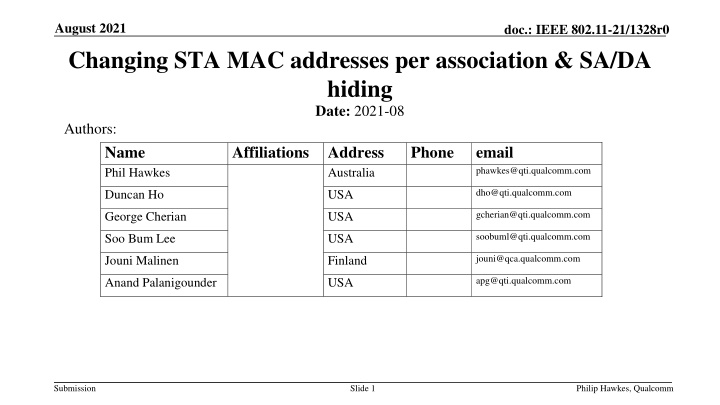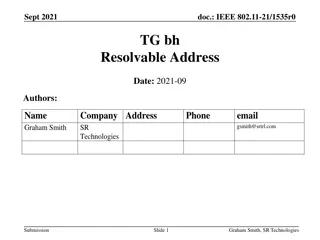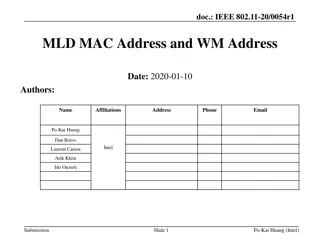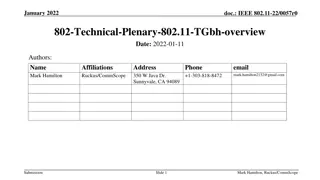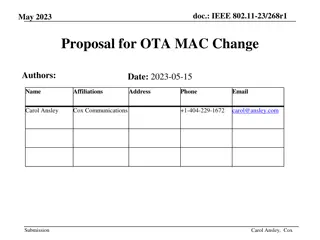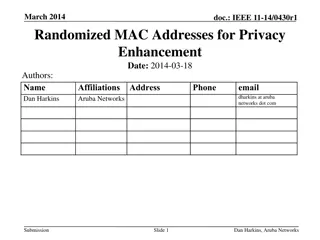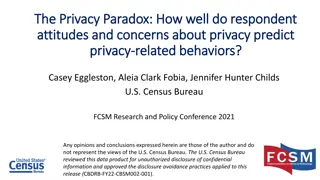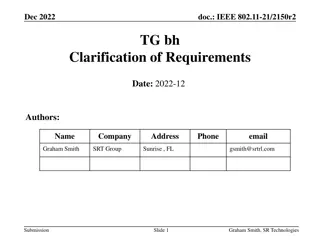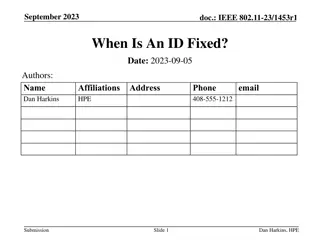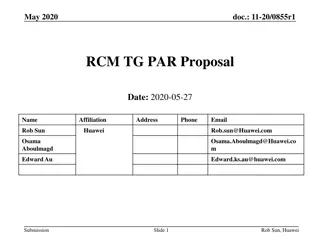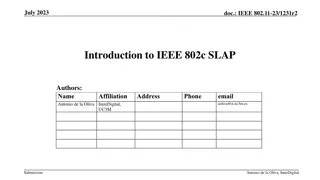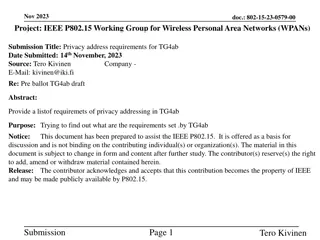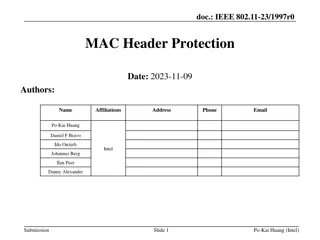Addressing Privacy Concerns in IEEE 802.11-21: Changing MAC Addresses for Improved Security
The document discusses the implications of changing STA MAC addresses per association in IEEE 802.11-21 standard to enhance privacy and security. It explores the challenges of maintaining persistent identifiers in data frames and the risks associated with sending source/destination addresses in clear OTA frames. Suggestions are provided for mitigating these issues in wireless networks.
Download Presentation

Please find below an Image/Link to download the presentation.
The content on the website is provided AS IS for your information and personal use only. It may not be sold, licensed, or shared on other websites without obtaining consent from the author.If you encounter any issues during the download, it is possible that the publisher has removed the file from their server.
You are allowed to download the files provided on this website for personal or commercial use, subject to the condition that they are used lawfully. All files are the property of their respective owners.
The content on the website is provided AS IS for your information and personal use only. It may not be sold, licensed, or shared on other websites without obtaining consent from the author.
E N D
Presentation Transcript
August 2021 doc.: IEEE 802.11-21/1328r0 Changing STA MAC addresses per association & SA/DA hiding Date: 2021-08 Authors: Name Phil Hawkes Affiliations Address Australia Phone email phawkes@qti.qualcomm.com dho@qti.qualcomm.com Duncan Ho USA gcherian@qti.qualcomm.com George Cherian USA soobuml@qti.qualcomm.com Soo Bum Lee USA jouni@qca.qualcomm.com Jouni Malinen Finland apg@qti.qualcomm.com Anand Palanigounder USA Submission Slide 1 Philip Hawkes, Qualcomm
August 2021 doc.: IEEE 802.11-21/1328r0 Abstract Problems: Client identifiers sent in clear OTA should change frequently, however: Regarding STA MAC address used OTA as TA/RA in 802.11 baseline TA/RA allowed to change for each association. However, not done due to impact on DS. TA/RA currently must persist for association, since AP processes received packets based on STA MAC address. Regarding STA MAC address used as SA/DA in the DS Legacy devices send & receive other devices SA/DA OTA. SA/DA available to all devices on DS. Potential Privacy issue. If SA/DA can change, should still persist for each association, to avoid impacting higher layer protocols. DS needs a client identifier persisting across multiple associations for managing connections. Submission Slide 2 Philip Hawkes, Qualcomm
August 2021 doc.: IEEE 802.11-21/1328r0 For Reference: Address fields TA = MAC address of the AP/STA transmitting the frame RA = MAC address of the AP/STA radio receiving the frame SA = MAC address of the source device (wired or wireless) of the frame Can be the same as TA DA = MAC address of the destination device (wired or wireless) receiving the frame Can be the same as RA Submission Slide 3 Philip Hawkes, Qualcomm
August 2021 doc.: IEEE 802.11-21/1328r0 Issues with Changing the OTA MAC address between Associations 802.11 baseline supports a client changing MAC address for each association. Changing MAC address for each association causes issues in the DS Theses issues caused by DS management relying on a persistent MAC address to identify client. Consequently, clients do not change MAC address for each association A persistent client identifier is needed which the DS can use to correlate multiple associations from the same client. This seems related to TGbh work is identifying and addressing issues related to changing the MAC address between associations. Submission Slide 4 Philip Hawkes, Qualcomm
August 2021 doc.: IEEE 802.11-21/1328r0 Issues with sending SA and DA in the clear OTA Problem Statement: SA and/or DA (when present) should not be sent in the clear in OTA frames This information does not need to be in the clear Sending this in the clear is a historical artefact How can attackers exploit SA/DA sent in the clear in OTA frames? Identify wired devices present in the DS For STA with static SA/DA address: identifying STA present in DS For STA with random SA/DA address: determining whether the STA is still present in the DS for duration of STA s SA/DA. Note: STA presence in DS can be detected in frames exchanged with any AP of the DS, even if the STA is outside the radio range of the attacker. Submission Slide 5 Philip Hawkes, Qualcomm
August 2021 doc.: IEEE 802.11-21/1328r0 Potential Solutions 3 tiers of client identifiers (using MLO Architecture). Affiliated STA MAC addresses (used as TA/RA): changes every association. For long- term association, perform new association to change addresses when needed. In clear OTA. Non-AP MLD MAC address (used SA/DA): can change every association (depending on use case). Encrypted OTA. Per-DS identifier: persistent across multiple associations with the DS. Encrypted OTA. (TGBh addressing this?) Hide SA/DA OTA Submission Slide 6 Philip Hawkes, Qualcomm
August 2021 doc.: IEEE 802.11-21/1328r0 Potential Solution: 3 Tiers of Client Identifier using MLO Architecture Identifier Usage Potential Solution Identifier Persistence Change randomly for each association Can change randomly for each association or persist across associations1 Persistent across associations within a single network. Can change randomly from one network to another Visibility over the air Unencrypted (in the clear) Encrypted2 (hidden) Affiliated STA MAC addresses Non-AP MLD MAC Address Identifying Client using TA or RA in over the-air frames Identifying Client using SA or DA in DS frames Persistent Identifiers Identifying Client across multiple associations with same network. Encrypted (hidden) 1. If higher layer protocols sessions continue to new association, then keep existing MAC address If higher layer protocols sessions do not continue to new association, then change MAC address In 802.11be, non-AP MLD is current exchanged in the clear (un-encrypted). This would need to change. 2. Submission Slide 7 Philip Hawkes, Qualcomm
August 2021 doc.: IEEE 802.11-21/1328r0 Potential Solution: Hiding SA and DA OTA Solution Summary: SA and/or DA (when present) are sent encrypted OTA SA and/or DA are extracted from frame header inserted into the frame body prior to applying encryption and integrity protection. Fields containing SA and/or DA may be either removed from frame header, or set to some value (e.g. all zeroes or random values). After applying integrity verification and decryption, SA and/or DA are extracted from the frame body and used in further processing of the frame. Note: SA/DA in frames used by legacy STAs will still reveal the per-association persistent MAC address (non-AP MAC Address) of source/destination STAs that use changing OTA MAC addresses (this slide). Note this is not an issue for a DS which prohibits STA-to-STA communications. Submission Slide 8 Philip Hawkes, Qualcomm
August 2021 doc.: IEEE 802.11-21/1328r0 SLIDES TO ADD TO 11-21-0641-R2 PROPOSED ISSUES (USE CASES) Submission Slide 9 Philip Hawkes, Qualcomm
August 2021 doc.: IEEE 802.11-21/1328r0 X) STA MAC address persistence Problem/Issue Current STA MAC address usage presents challenges to providing privacy. MAC address used for TA/RA does not change MAC address used for DA/SA does not change Additional challenges DS requires an identifier for correlating associations from a single STA Currently using the MAC Address, and we want to change MAC address to improve privacy MAC address for DA/SA is used in upper layers. Changing these within association impacts upper layers MAC address for TA/RA is used for received packet filtering at the AP. Status [Text indicating when use case was presented and any agreements on the use case.] Reference (This contribution) Submission Slide 10 Philip Hawkes, Qualcomm
August 2021 doc.: IEEE 802.11-21/1328r0 Y) Tracking SA and DA OTA Problem/Issue SA and DA are currently sent in the clear OTA. This reveals MAC addresses used in the DS, which allows /tracking Identifying Wired Devices Identifying 802.11 radios which use static MAC addresses for SA/DA in DS. Tracking network presence of 802.11 radios which support random MAC address for SA/DA in DS (for lifetime of each SA/DA address) Status [Text indicating when use case was presented and any agreements on the use case.] Reference (This contribution) Submission Slide 11 Philip Hawkes, Qualcomm
